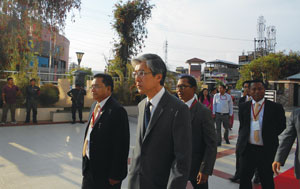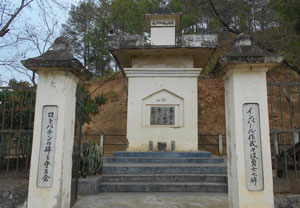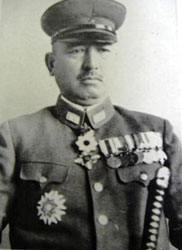Archives
The 70th anniversary of the second world war
From March to July in 1944, over 200,000 Britons, Indians, Gurkhas, Japanese and several others clashed in the hills and valley of Manipur. This has been described as one of the greatest battles of the 2nd World War. On April 20, 2013, the combined battle of Kohima and Imphal was termed as Britain’s greatest battle by the National Army Museum of the United Kingdom.
The 70th Anniversary was opened on the 23rd of March at Manipur Film Development Corporation (MFDC) auditorium, Imphal. In his speech, Takshi Yagi, envoy of Japan to India who attended the battle of Imphal Anniversary function said, “Relations between India and Japan have been improving after 70 years of the outbreak of World War 2.” The Ambassador Takeshi Yagi said that the event remains an unforgettable event for the Japanese people. He also appealed to the people of Manipur to preserve and protect the war memorials built in the State. Further he stressed that Japan shares a cordial diplomatic relationship with India.
(MFDC) auditorium, Imphal. In his speech, Takshi Yagi, envoy of Japan to India who attended the battle of Imphal Anniversary function said, “Relations between India and Japan have been improving after 70 years of the outbreak of World War 2.” The Ambassador Takeshi Yagi said that the event remains an unforgettable event for the Japanese people. He also appealed to the people of Manipur to preserve and protect the war memorials built in the State. Further he stressed that Japan shares a cordial diplomatic relationship with India.
The inaugural function was also attended by the State Chief Secretary, PC Lawmkunga as the Chief Guest, Additional Chief Secretary RR Rashmi, Principal Secretary Dr. Rajesh Kumar, Commissioner Dr. RK Nimai and the President of MTF Dr. Dabhali Singh as the guests of honour. The inaugural function also featured a photo exhibition, relics display and the screening of a short film besides other events. Incidentally, London based Japanese actor Junichi Kajioka is currently making a film, ‘Imphal-1944’ in London. The film was premiered at the 70th Anniversary of the battle of Imphal on June 28th and later at film festivals around the world.
|
The Situation
20th Indian Infantry Division occupied Tamu, 110 kilometres (68 mi) south-east of Imphal. The division was untried but well-trained. 17th Indian Infantry Division occupied Tiddim, 243 kilometres (151 mi) south of Imphal, at the end of a long and precarious line of communication. The division, which had two brigades only, had been intermittently in action since December 1941. |
There were a series of battles which took place in Manipur during the Second World War namely the battle of Kanglatongbi, the battle of Kameng, the battle of Red Hills, the battle of Motbung, the battle of Sangsak, the battle of Nunghigum, the air battle at Imphal, the battle at Tengnoupal, the battle at Bisnupur, the battle at Silchar track etc.
In 1942 Manipur found itself on the frontier between the British in India and the Japanese in Burma (Myanmar) and turned into a massive battleground in 1944, when the Japanese with Indian National Army (INA) made inroads into India. The period between March and July of that year saw fierce battles taking place across the State in what is better known as the Battle of Imphal. Also Kohima in Nagaland was another turning point in the Burma campaign of the 2nd World War. It was at Kohima - Imphal that the Japanese invasion of India and Japan’s march through Asia was stopped when the British led Allies drove them out of Burma in 1945. The Japanese lost some 30,000 men in what was one of their worst military defeats. British military historian Robert Lyman says that the Kohima -Imphal episode was one of the four great turning point battles of the 2nd World War.
(Myanmar) and turned into a massive battleground in 1944, when the Japanese with Indian National Army (INA) made inroads into India. The period between March and July of that year saw fierce battles taking place across the State in what is better known as the Battle of Imphal. Also Kohima in Nagaland was another turning point in the Burma campaign of the 2nd World War. It was at Kohima - Imphal that the Japanese invasion of India and Japan’s march through Asia was stopped when the British led Allies drove them out of Burma in 1945. The Japanese lost some 30,000 men in what was one of their worst military defeats. British military historian Robert Lyman says that the Kohima -Imphal episode was one of the four great turning point battles of the 2nd World War.
|
The Japanese plan In March 1943, the Japanese command in Burma had been reorganised. A new headquarters, Burma Area Army, was created under Lieutenant-General Masakazu Kawabe. One of its subordinate formations, responsible for the central part of the front facing Imphal and Assam, was Fifteenth Army. Lieutenant-General Renya Mutaguchi was appointed to command this army in July 1943. From the moment he took command, Mutaguchi forcefully advocated an invasion of India. His motives for doing so appear to be complex and he believed it was his destiny to win the decisive battle of the war for Japan. |
The battle saw Japanese and INA units attacking Manipur from different directions in March, 1944. The British had always planned to withdraw their two forward divisions deployed along the India - Burma border. The idea was to fight the latter in conditions favourable to the British. It is not easy to describe the flow of the battle of Imphal as the war was spread out across Manipur and other areas. In a way, Imphal witnessed little fighting during the 1944 War to which it lends its name. Fighting raged all around the city and even occurred as close as Nungshigam to the North and Maibam Lokpaching in the South. Imphal was cut off from the rest of the world by land for almost two months. Militarily Imphal remained as the nerve centre where the British 4th Corps directly ran and co-ordinated the Battle of Imphal. The 14th Army HQ moved to Imphal for a few months towards the end of 1944 to co-ordinate the unfolding operations in Burma. The Victoria Cross, Britain’s highest military honour for bravery, was conferred to five people during the Battle of Imphal namely Jamadar Abdul Hafiz, the first Muslim to be awarded the Victoria Cross in the Second World War, Sergeant Hanson Victor Turner on June 7, 1944, Rifleman Ganju Lam on June 12, 1944, Naik Agansing Rai on June 26, 1944 and Subedar Netrabahadur Thapa on June 26, 1944.
The Victoria Cross, Britain’s highest military honour for bravery, was conferred to five people during the Battle of Imphal namely Jamadar Abdul Hafiz, the first Muslim to be awarded the Victoria Cross in the Second World War, Sergeant Hanson Victor Turner on June 7, 1944, Rifleman Ganju Lam on June 12, 1944, Naik Agansing Rai on June 26, 1944 and Subedar Netrabahadur Thapa on June 26, 1944.
Then the battle of Imphal and the INA is another very interesting  story. INA was spearheaded by Netaji Subas Chandra Bose. The men of the INA first entered India and engaged in battle against their former Indian comrades of the British Army. The fighting groups entered Manipur together with Japanese forces in March, 1944. On April 14, Colonel Malik of the Bahadur Group hoisted the Indian tri-colour for the first time at Moirang (Manipur), where the INA Memorial stands today. Around 7,000 men from the INA’s 1st Division also participated in the Battle of Imphal and its HQ was set up in Chamol. However, the INA met the same fate as the larger force they accompanied and all the brigades began their withdrawal on July 18, 1944. By the middle of January, 1944, Lieutenant General Christison began his offensive in the Arakkan front to capture the Maungdaw - Buthidong road. The Japanese were also not sitting idle. The British Prime Minister at that time Sir Winston Churchill wrote, “The Japanese also had a plan. Since November they had increased their strength in Burma from five divisions to eight and they proposed to invade Eastern India and raise the flag of rebellion against the British.” So Manipur was that part of India that was most affected by the World War and was changed in many ways because of this War.
story. INA was spearheaded by Netaji Subas Chandra Bose. The men of the INA first entered India and engaged in battle against their former Indian comrades of the British Army. The fighting groups entered Manipur together with Japanese forces in March, 1944. On April 14, Colonel Malik of the Bahadur Group hoisted the Indian tri-colour for the first time at Moirang (Manipur), where the INA Memorial stands today. Around 7,000 men from the INA’s 1st Division also participated in the Battle of Imphal and its HQ was set up in Chamol. However, the INA met the same fate as the larger force they accompanied and all the brigades began their withdrawal on July 18, 1944. By the middle of January, 1944, Lieutenant General Christison began his offensive in the Arakkan front to capture the Maungdaw - Buthidong road. The Japanese were also not sitting idle. The British Prime Minister at that time Sir Winston Churchill wrote, “The Japanese also had a plan. Since November they had increased their strength in Burma from five divisions to eight and they proposed to invade Eastern India and raise the flag of rebellion against the British.” So Manipur was that part of India that was most affected by the World War and was changed in many ways because of this War.
|
It all Goes Wrong for Japan All Mutaguchi’s divisional commanders disagreed with the plan to some extent. Their main reservations concerned supply. Mutaguchi had assumed that success would be achieved within three weeks, but adequate supplies after that period could be obtained only if the Japanese captured Allied supply dumps, as the torrential rains that the spring season would inevitably bring would make supply routes from the Chindwin impossible to traverse. Mutaguchi proposed to use ‘Genghis Khan’ rations, driving herds of buffalo and cattle rounded up throughout northern Burma across the Chindwin as meat rations on the hoof. Most of these unfortunate beasts died from lack of forage and rotted many miles from the troops they were intended to supply. |
Even as Manipur was commemorating this 70th anniversary of the Second World War, a newly set up Imphal War Museum was also inaugurated. The opening ceremony was attended by 12 family members of British soldiers who fought the Japanese army during the Second World War. The Museum was inaugurated as a part of the 70th Anniversary of Battle of Imphal by the World War-2 Imphal Campaign Foundation. It was inaugurated by Christopher D Johnson from the UK. Christopher said, “I want more promotion of development of the new museum.” Others present were Andrew Boyd, Michael Boyd and Francis Boyd sons of Major Boyd of the British Army who fought in the Battle of Imphal. In his speech, Francis Boyd said that he and his two brothers emotionally think that they belong to Manipur because his parents fell in love while they were serving the British Army during the 2nd World War in Manipur. Later the participants paid floral tributes to the departed souls of the 2nd World War.

 At the start of 1944, the war was going against the Japanese on several fronts. They were being driven back in the central and south west Pacific, and their merchant ships were under attack by Allied submarines and aircraft. In south east Asia, they had held their lines over the preceding year, but the Allies were preparing several offensives from India and the Chinese province of Yunnan into Burma. In particular, the town of Imphal in Manipur on the frontier with Burma was built up to be a substantial Allied logistic base, with airfields, encampments and supply dumps. Imphal was linked to an even larger base at Dimapur in the Brahmaputra River valley by a road which wound for 100 miles (160 km) through the steep and forested Naga Hills.
At the start of 1944, the war was going against the Japanese on several fronts. They were being driven back in the central and south west Pacific, and their merchant ships were under attack by Allied submarines and aircraft. In south east Asia, they had held their lines over the preceding year, but the Allies were preparing several offensives from India and the Chinese province of Yunnan into Burma. In particular, the town of Imphal in Manipur on the frontier with Burma was built up to be a substantial Allied logistic base, with airfields, encampments and supply dumps. Imphal was linked to an even larger base at Dimapur in the Brahmaputra River valley by a road which wound for 100 miles (160 km) through the steep and forested Naga Hills.